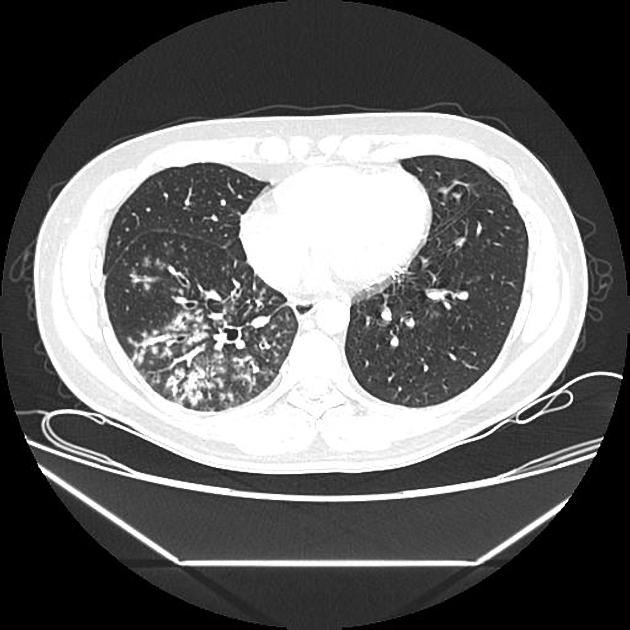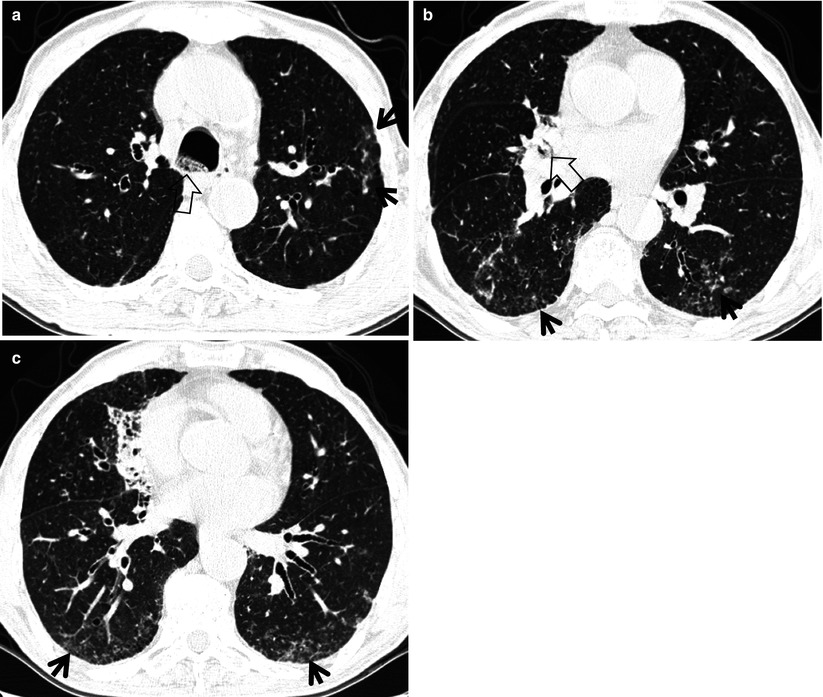tree in bud opacities seen in
The purpose of this study was to determine the relative frequency of causes of tib opacities and identify patterns of disease associated with tib opacities. Tree-in-bud TIB opacities are a common imaging finding on thoracic CT scan.
In radiology the tree-in-bud sign is a finding on a CT scan that indicates some degree of airway obstruction.

. Multiple causes for tree-in-bud TIB opacities have been reported. The tree-in-bud pattern is commonly seen at thin-section computed tomography CT of the lungs. Tuberculosis many infectious organisms can produce this pattern.
Although initially described in 1993 as a thin-section chest CT finding in active tuberculosis TIB opacities are by. 8081 On CT the tree-in-bud pattern manifests as small 24 mm centrilobular well-defined nodules connected to linear branching opacities that. It is usually visible on standard ct however it is best seen on hrct chest.
Another important entity that can produce the tree-in-bud pattern is bronchioalveolar carcinoma BAC. CT confims numerous centrilobular nodules with opacified distal bronchioles tree-in-bud sign and bronchiectasisThese findings most likely represents pulmonary TB or MAC despite negative induced sputum specimens. It consists of small centrilobular nodules of soft-tissue attenuation connected to multiple branching linear structures of similar caliber that originate from a single stalk.
Tree in Bud Sign Bronchopulmonary Aspergillosis ABPA CT scan through the chest shows medium sized bronchi bronchioles and small airways impacted with fluid. Jennifer hong ba francisca zuazo md hanyuan shi md 1 1 tulane university la new orleans. Uncommonly this pattern can be seen in other entities that cause luminal impaction bronchiolar dilatation or wall thickening including cystic fibrosis immune deficiency inflammatory bowel disease and diffuse panbronchiolitis.
The differential diagnosis is lengthy. Multiple causes for tree-in-bud TIB opacities an imaging pattern usually seen on chest CT have been reported. Tree-in-bud TIB opacities are a common imaging finding on thoracic CT scan.
This is the classic appearance of the tree in bud pattern seen on chest ct. However the most common process leading to this CT appearance is infection. However to our knowledge the relative frequencies of the causes have not been evaluated.
The purpose of this study was to determine the relative frequency of causes of TIB opacities and identify patterns of disease associated with TIB opacities. Originally and still often thought to be specific to endobronchial Tb the sign is actually non-specific and is the manifestation of pus mucus fluid or other. The purpose of this study was to determine the relative frequency of causes of TIB opacities and identify patterns of disease associated with TIB opacities.
Multiple causes for tree-in-bud TIB opacities an imaging pattern usually seen on chest CT have been reported. Found that the tree-in-bud pattern was seen in 256 of the CT scans in patients with bronchiectasis. However to our knowledge the relative frequencies of the causes have not been evaluated.
Usually somewhat nodular in appearance the tree-in-bud pattern is generally most pronounced in the lung periphery and associated with abnormalities of the larger airways. TIB opacities are also associated with bronchiectasis and small airways obliteration resulting in mosaic air trapping. Mycobacterium avium complex is the most common cause in most series.
TIB opacities represent a normally invisible branches of the bronchiole tree 1 mm in diameter that are severely impacted with mucous pus or fluid with resultant dilatation and budding of the terminal bronchioles 2 mm in diameter1 photo. The tree-in-bud pattern is commonly seen at thin-section computed tomography CT of the lungs. This collage is presented to reveal tree in bud changes resulting from impaction in the smaller terminal bronchioles and respiratory units.
2 However the classic cause of tree-in-bud is Mycobacterium tuberculosis especially when it is active and contagious and associated with cavitary lesions. The tree-in-bud pattern occurs commonly in pa-tients with endobronchial spread of Mycobacte-rium tuberculosis and is highly suggestive of active tuberculosis 23. Tree-in-bud TIB opacities are a common imaging finding on thoracic CT scan.
The tree-in-bud sign is a nonspecific imaging finding that implies impaction within bronchioles the smallest airway passages in the lung. 3 Aspiration is also a common cause of the tree-in-bud formation. 1 It is important for clinicians to remember that this pattern has an extensive.
Multiple causes for tree-in-bud TIB opacities have been reported. 11 TIB opacities represent a central imag- Background. Fall when the leaves start to fall off the trees is a good time to spot tree buds.
Tree-in-bud refers to a pattern seen on thin-section chest CT in which centrilobular bronchial dilatation and filling by mucus pus or fluid resembles a budding tree. Lessons from a Tree Bud. What does tree-in-bud opacities mean.
The tree-in-bud sign indicates bronchiolar luminal impaction with mucus pus or fluid causing normally invisible. It consists of small centrilobular nodules of soft-tissue attenuation connected to multiple branching linear structures of similar caliber that originate from a single stalk. These small clustered branching and nodular opacities represent terminal airway mucous impaction with adjacent peribronchiolar inflammation.
Tree in bud opacification refers to a sign on chest CT where small centrilobular nodules and corresponding small branches simulate the appearance of the end of a branch belonging to a tree that is in bud. Chest x-ray in a 60 year old patient of Asian extraction demonstrates faint reticulonodular opacities. Although commonly associated with M.
Change the water and cut an inch off stems each week. The tree-in-bud pattern indicates disease affecting the small airways. Bronchiectasis which may be of any cause can produce the tree-in-bud pattern.
TIB opacities are also associated with bronchiectasis and small airways obliteration resulting in mosaic air trapping. Tree in bud opacities seen in. Tree in bud opacities treatment.
The tree-in-bud pattern is commonly seen at thin-section computed tomography CT of the lungs. However in the presence of disease processes which involve the bronchioles ie infectious or inflammatory conditions they can easily be. Tree in bud opacities treatment.
High-resolution CT usually reveals small 24-mm centrilobular nodules and branching linear opacities of similar caliber originating from a single stalk Figs 2 3 4.

Tree In Bud Pattern Pulmonary Tb Eurorad

Tree In Bud Caused By Haemophilus Influenzae Radiology Case Radiopaedia Org

Tree In Bud Appearance Radiology Case Radiopaedia Org

Computed Tomography Of The Chest Showed Nodular Opacities With Tree In Download Scientific Diagram

Chest Ct With Multifocal Tree In Bud Opacities Diffuse Bronchiectasis Download Scientific Diagram
View Of Tree In Bud The Southwest Respiratory And Critical Care Chronicles

Hrct Scan Of The Chest Showing Diffuse Micronodules And Tree In Bud Download Scientific Diagram

Areas Showing A Mosaic Pattern Of Attenuation And Tree In Bud Opacities Download Scientific Diagram

Tree In Bud Pattern Radiology Case Radiopaedia Org

Tree In Bud Sign Radiology Key

Tree In Bud Pattern Pulmonary Tb Eurorad

Tree In Bud Sign Lung Radiology Reference Article Radiopaedia Org

References In Causes And Imaging Patterns Of Tree In Bud Opacities Chest

